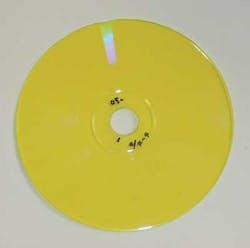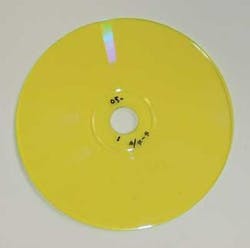Terabyte optical disc relies on two-photon process
Using two-photon optics and a variation of polymethylmethacrylate called ePMMA (with a natural yellow color), scientists at Mempile (Neve Ilan, Israel) have developed a removable optical storage technology that can hold 1 terabyte of information on a single inexpensive “TeraDisc.”
Within the ePMMA media, 200 layers, 5 µm apart, are created by a red laser. Instead of the pits and flat surfaces on a compact disc or digital video disc, Mempile implemented a nonlinear two-photon absorption process. When the laser beam is focused to a small radius on the disc, photons excite the chromophores in the ePMMA molecules, switching them between two distinct states. However, when the radius of the beam increases, it becomes improbable for two photons to arrive simultaneously at a chromophore, and therefore no writing or reading can occur outside of the focus. This allows the three-dimensional addressing of small volumes within the material. Reading is performed in a similar way, but with light causing the chromophores to fluoresce. The amount of fluorescence is dependent on whether the point at the focus contains “written” or “unwritten” chromophore molecules. Commercial availability of the product is scheduled for 2010. Contact Beth Erez at [email protected].

